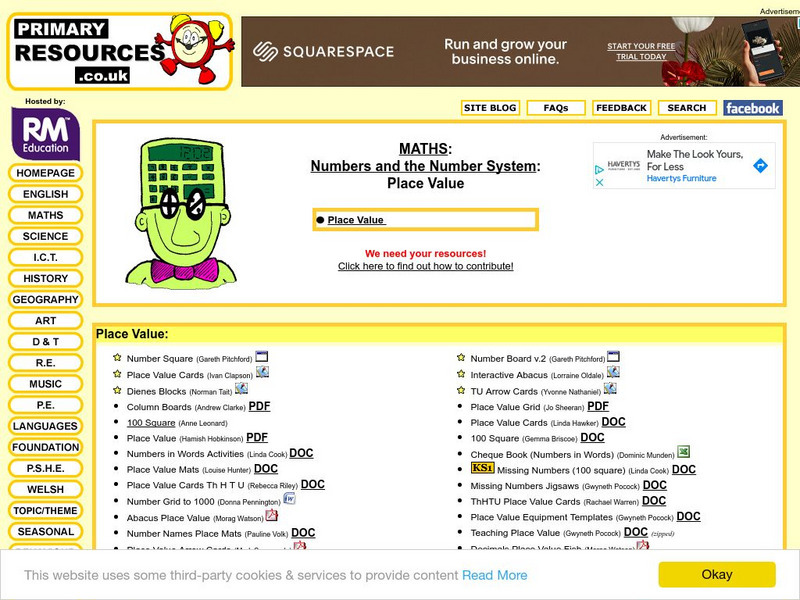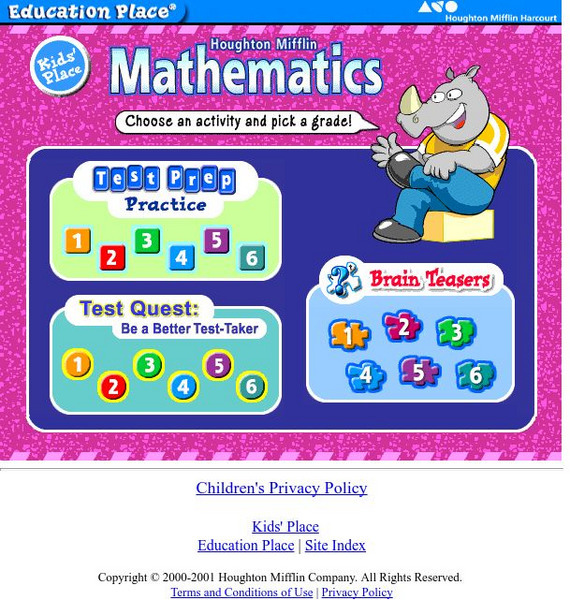Hi, what do you want to do?
Pennsylvania Department of Education
What Balances?
Students explore another meaning of subtraction as it pertains to the inverse of addition. In this what balances lesson, students identify the concept of subtraction as a balance. Students use subtraction facts to generate addition...
Pennsylvania Department of Education
Seeing Doubles
Students work with dominoes to recognize the number of spots on each side as they relate to addition facts. In this seeing doubles activity, students make triangle shaped flash cards for the double facts. Students represent the correct...
Pennsylvania Department of Education
Multiple Patterns
Young scholars explore patterns that involve doubling numbers. For this multiple patterns lesson, students use objects to explore these patterns while recording them using a table. Young scholars recognize even and odd number patterns...
Curated OER
Greater Than, Less Than, Equal to
First graders complete number comparison activities. In this number comparisons lesson plan, 1st graders review the names of comparison symbols and participate in visual comparison activities. Students practice using the gator and clam...
Curated OER
Color Me Green If I Am a Five
First graders count by 5's to 100. They use a number chart to identify and mark all numbers ending in five or zero. They use the charts to participate in choral counting.
Curated OER
Valentine's Themed Activities For February
Here are ways to make academics part of your Valentine's Day-related lessons.
Curated OER
Measure This!
Students estimate the measurement in centimeters for common classroom objects. They check their estimations, discuss the differences and write a paragraph summarizing the activity.
Texas Commission on the Arts
The Quarter Fold
Little ones identify the US quarter and explore the concept of one-fourth or one-quarter. Using real coins or coin manipulatives, they divide a square piece of paper into quarters, discuss halves and quarters, and create a design that...
Alabama Learning Exchange
Partying with Two/Three Digit Whole Numbers
Learners practice problem-solving with this addition activity. They plan a party for their class and another class by determining how many cupcakes are needed. Students draw a picture of how they determined the number of cupcakes.
Curated OER
All About Me
Students answer short answer questions, state their likes and dislikes, say what roles they have, and more about themselves. For this all about me lesson plan, students read books about how we are all different and the same.
Curated OER
Probability or Ability?
Students toss candy and coins using their non-dominant hand while their partners records the results on a probability charts.
Curated OER
Bar Charts and Pictographs: How can they help us?
First graders work with manipulatives to solve various math problems by using concrete objects to solve a list of problems . They create and evaluate bar graphs and write a statement about the information on their bar graph.
Curated OER
Making Sense of the Census
In this unit of lessons, learners make sense of the Census. They examine why a census is taken and participate in activities.
Curated OER
Even and Odd Numbers
First graders recognize characteristics of odd and even numbers. They listen to the story "Bears Odd, Bears Even" and create a pictures showing comprehension of odd and even numbers.
Curated OER
How Many Months?
Young scholars investigate the first Peter the Mint Eagle, who lived at the Philadelphia Mint from 1830 to 1836. They determine how many months Peter was there and use pictures, numbers, equations, and/or words to explain how they came...
Curated OER
Leprechaun Treasure Hunt
Students play a relay race game that gives them points for finding and retrieving hidden items. They record data on a graph.
Curated OER
Build a Snowplow
Learners design and build a snowplow using LEGO materials. They compete in an Engineer's Challenge to clear a path through Styrofoam peanuts.
Other
Nearpod: Place Value: Fall Edition
In this lesson plan, students will use base ten blocks and a place value chart to show their understanding of two-digit and three-digit numbers. They will also use place value to compare numbers.
Other
Nearpod: Introduction to Place Value
In this lesson on place value, 1st graders explore tens and ones, learn key vocabulary, and apply their learning to correct a mistake.
Primary Resources
Primary Resources: Place Value
A huge collection of teacher resources for teaching place value. There are games, PowerPoint presentations, pdf files, Word files, Excel files, Publisher files, and smartboard activities available for download at several different skill...
Other
Rice Romp: Place Value Lesson Plan
Take a look at the mathematics involved in the story "One Grain of Rice". Included is a lesson plan, geared toward 2nd-grade math students, about place value. A link to a quiz on the story is included.
Education Place
Houghton Mifflin: Eduplace: Kids' Place Mathematics
Educational publisher Houghton Mifflin provides a colorful, engaging site that offers test-prep practice, test-taking strategies, and brain teasers on a variety of math concepts for grades 1-6. Just "Choose an activity and pick a grade,"...
Education Place
Houghton Mifflin: Eduplace: Kids' Place Mathematics
Educational publisher Houghton Mifflin provides a colorful, engaging site that offers test-prep practice, test-taking strategies, and brain teasers on a variety of math concepts for grades 1-6. Just "Choose an activity and pick a grade,"...
ClassFlow
Class Flow: Place Value Ones and Tens
[Free Registration/Login Required] This flipchart helps students identify the actual values of ones and tens. By the end of the lesson, students will recognize the numeric representations of values from 1-99.



























